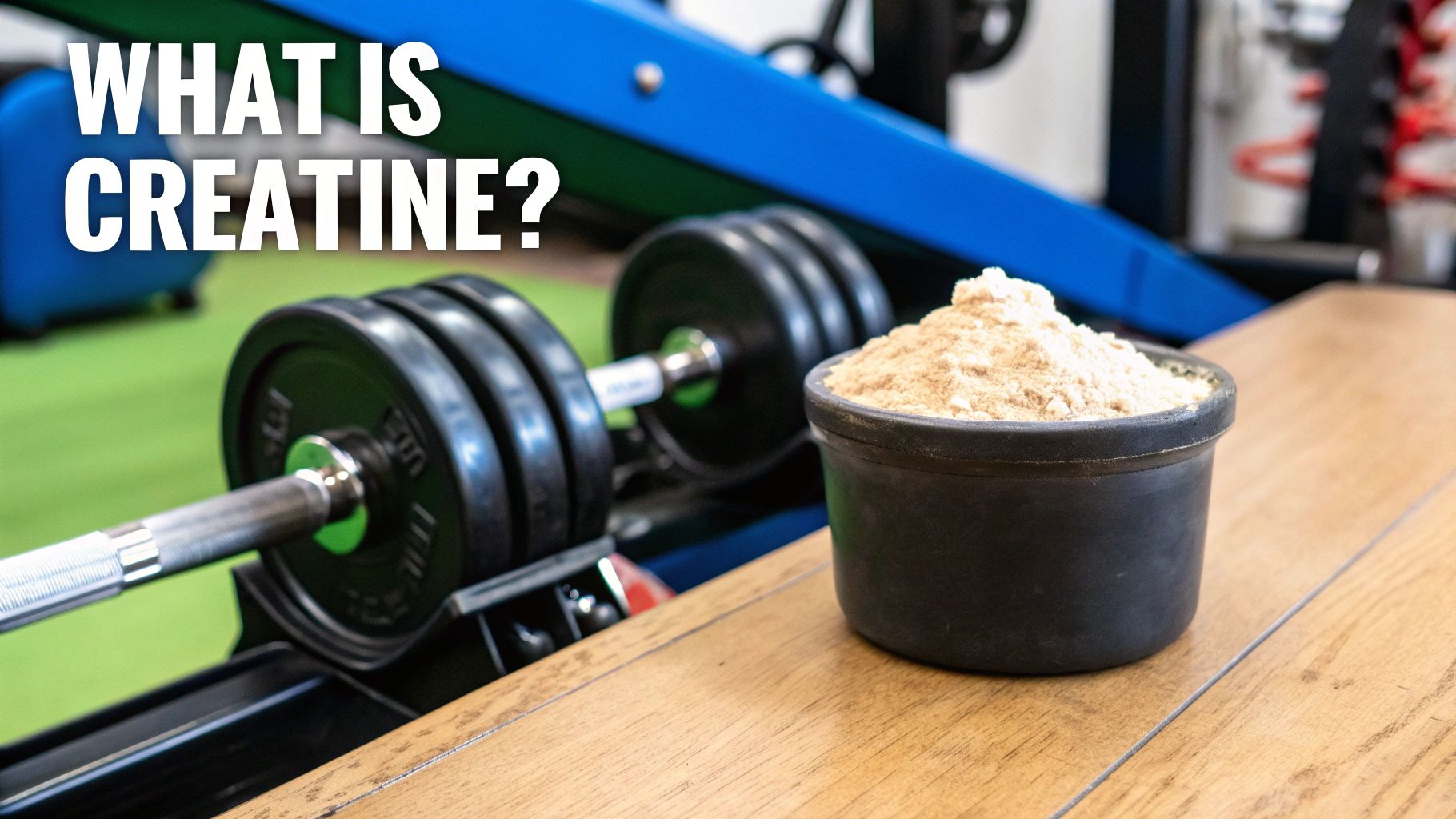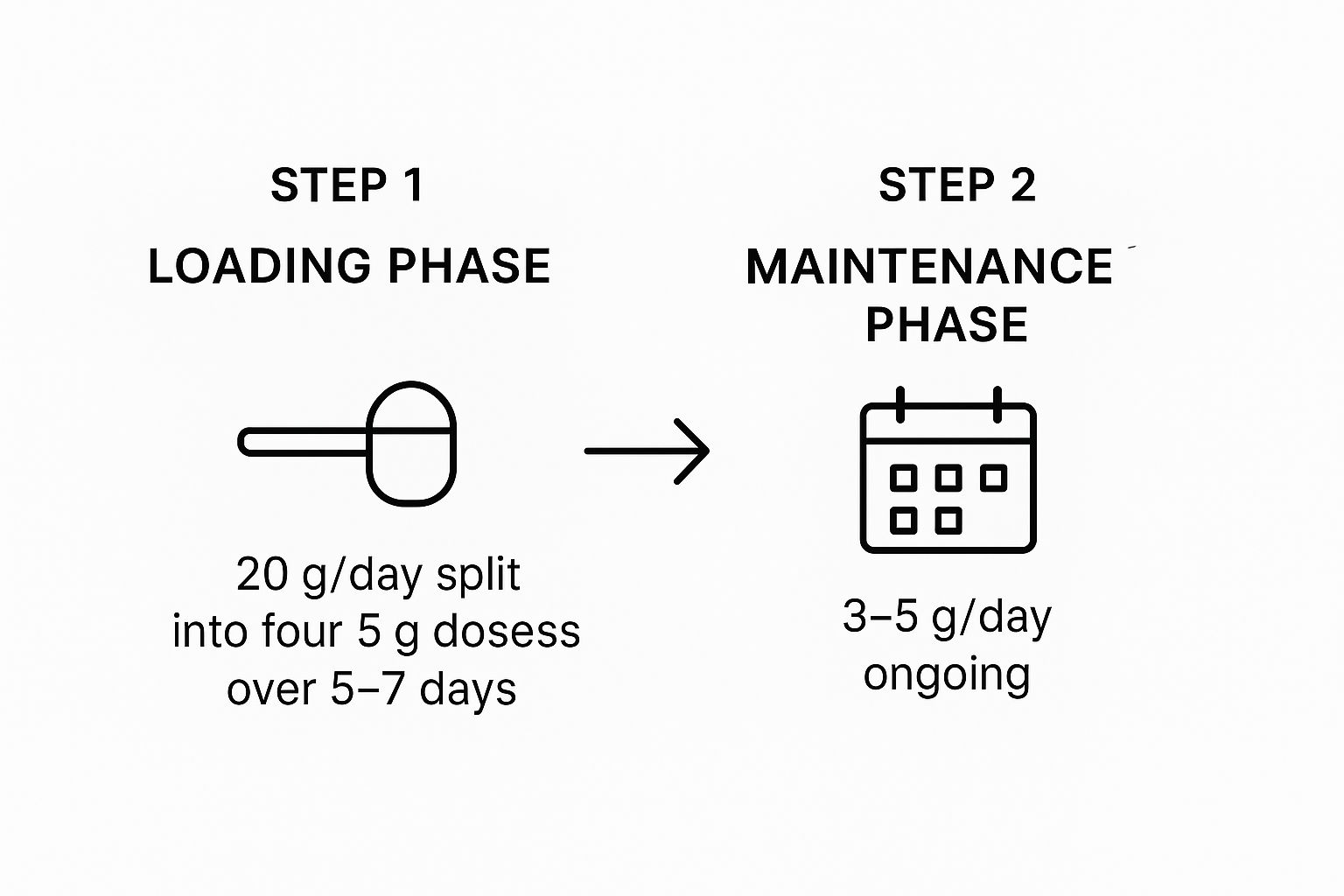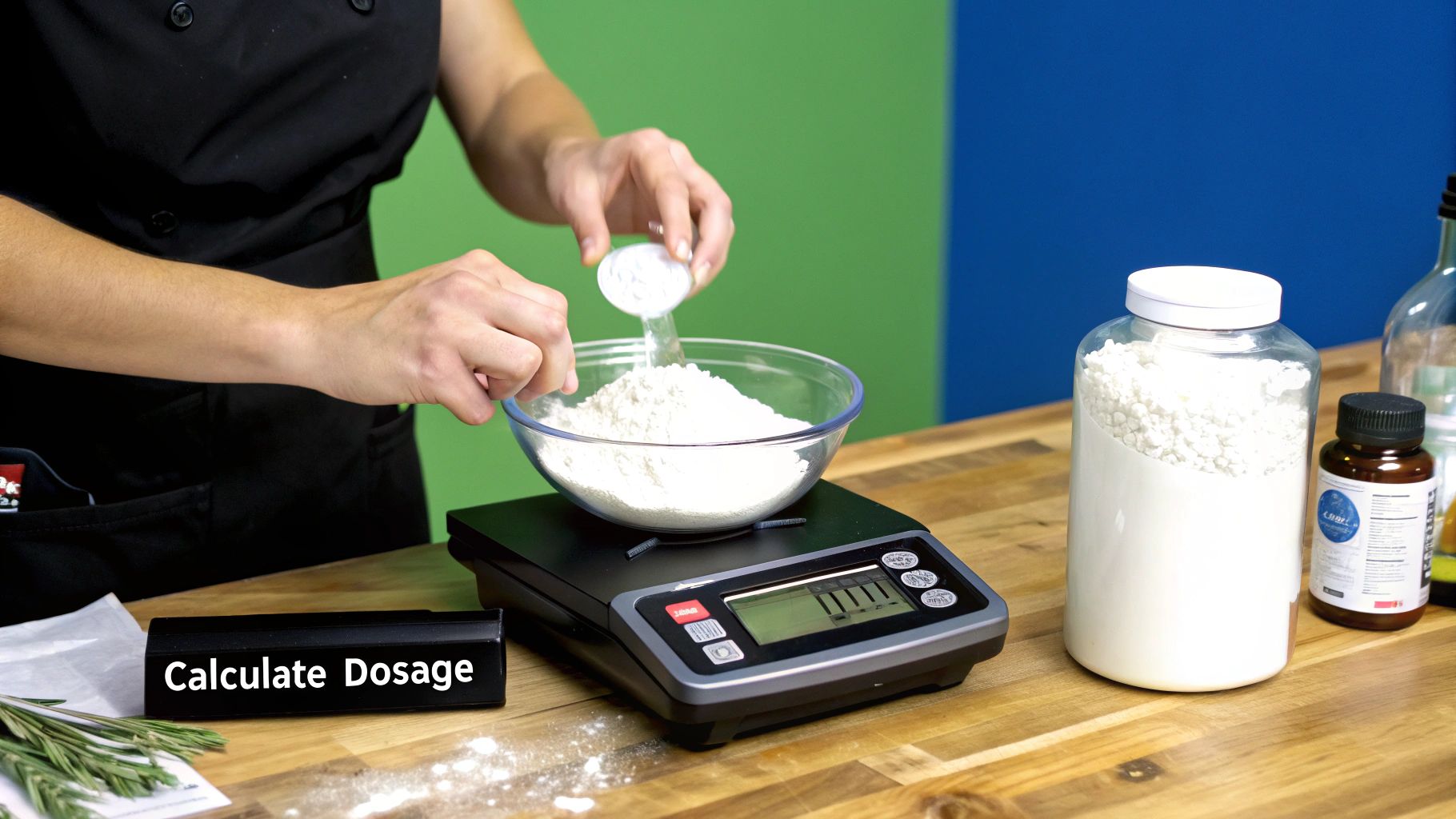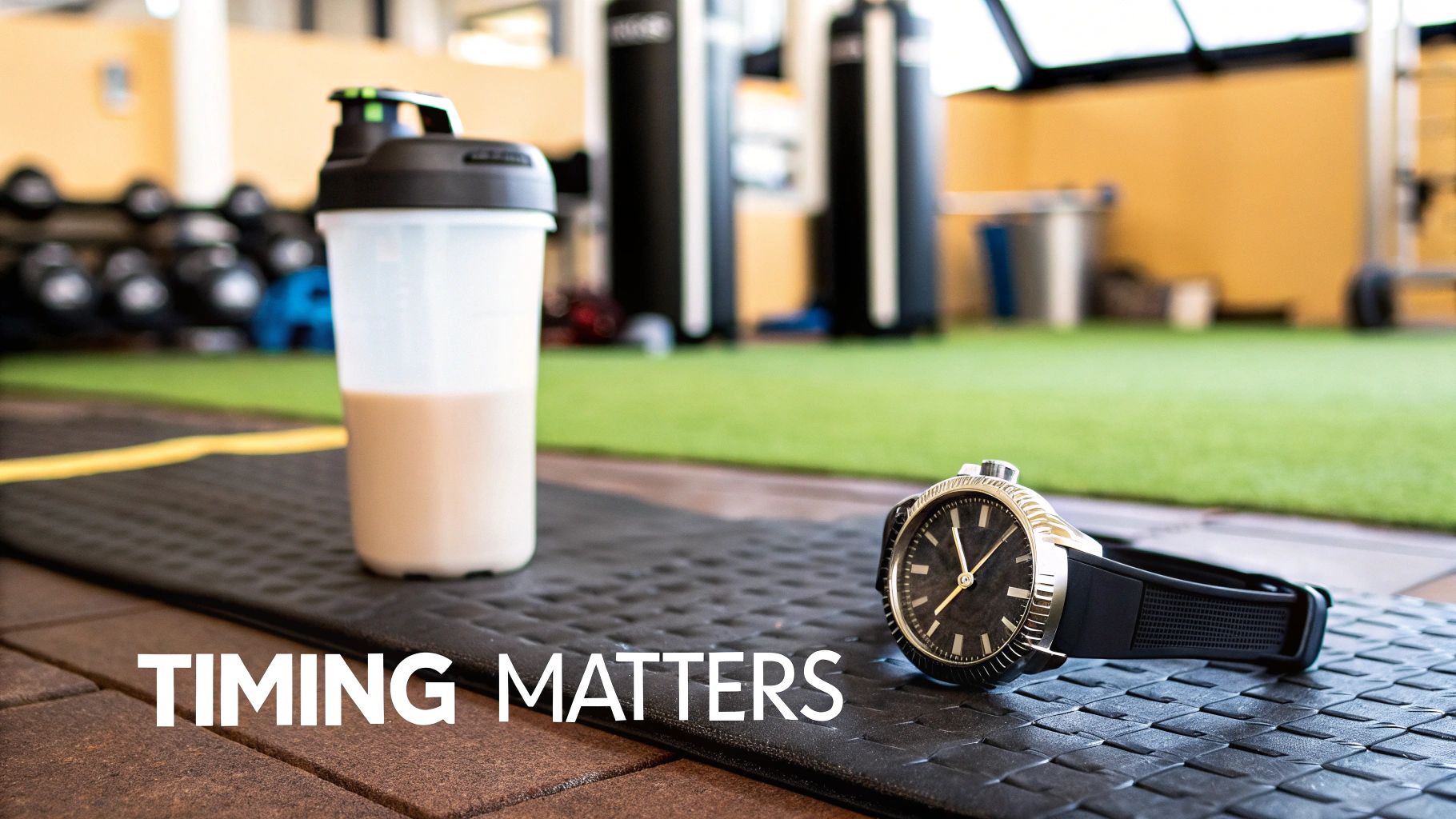
Your Ultimate Creatine Dosage Guide for Max Results
Share
So, how much creatine should you actually take? Let's cut through the gym-floor chatter and get straight to what works.
The good news is, it's not complicated. While the supplement world can feel overwhelming, your creatine strategy really boils down to two proven paths. Both get you to the same place: fully saturated muscles ready for peak performance.
Think of your muscles like a sponge. Creatine is the water. To get the most out of that sponge, you need to soak it completely. The loading phase and the maintenance dose are just two different ways to get it done.
The Two Paths to Peak Performance
You’ve got two main options, both backed by solid science. The best one for you just depends on your goals and how quickly you want to feel the effects.
-
The Loading Phase (The Fast Track): This is all about speed. You’ll take a higher dose of 20 grams per day for 5-7 days. Most people split this into four 5-gram servings throughout the day to help with absorption and avoid any potential stomach issues. This method gets your muscles saturated fast, and you can often feel a difference in your training in about a week.
-
The Maintenance Dose (The Steady Route): This is the simpler, more straightforward approach. You just take 3-5 grams of creatine every single day right from the start. It takes a bit longer to reach full saturation—usually about three to four weeks—but it’s just as effective in the long run and can be easier on your system.
Key Takeaway: Both loading and maintenance get you to the exact same endpoint—fully saturated muscles. The only real difference is how quickly you get there. It’s all about whether you want to sprint to the finish line or take a more measured jog.
No matter which path you start with, the long-term game is the same. Once your muscles are saturated, you’ll drop down to that 3-5 gram daily maintenance dose to keep your levels topped off. That's it. Consistency is the secret sauce here, not some complicated formula. Stick with it daily, and you'll unlock what creatine has to offer.
Let's break down these two common protocols side-by-side to make your choice even clearer.
Standard Creatine Dosing Protocols at a Glance
This table gives you a quick snapshot of the two most common creatine dosing strategies, helping you decide which route is best for your goals.
| Dosing Strategy | Daily Dosage | Duration | Time to Full Saturation |
|---|---|---|---|
| Loading Phase | 20 grams (split into 4 doses) | 5-7 Days | ~1 Week |
| Maintenance Dose | 3-5 grams | Ongoing | ~3-4 Weeks |
Ultimately, both roads lead to the same destination. One is an express lane, and the other is the scenic route. After the initial period, both strategies merge onto the same highway: a consistent daily maintenance dose to keep you performing at your best.
How Creatine Actually Works in Your Body

Before we get into dosing strategies, it’s worth understanding what’s actually happening inside your body when you take creatine. Think of your muscles as high-performance engines. For any quick, explosive movement—like the first few reps of a heavy squat or a flat-out sprint—those engines need instant, high-octane fuel.
That fuel is a molecule called adenosine triphosphate (ATP). It’s the direct source of energy for your most powerful muscle contractions. Here’s the catch: your muscles only store enough ATP for a few seconds of all-out effort. That’s it.
This is where creatine steps in. Your body converts supplemental creatine into a compound called phosphocreatine and stores it directly in your muscles. Essentially, it acts as a rapid-fire recycling system for your ATP, helping you regenerate that high-octane fuel on the fly.
The Power of Muscle Saturation
Let's use an analogy. Imagine your muscles have a built-in energy tank for this explosive power. With a normal diet, that tank is probably sitting somewhere around 60-80% full. It gets the job done, but there's untapped potential.
When you start supplementing with creatine, you're essentially topping off that tank until it hits 100%. That fully-fueled state is what we call muscle saturation.
Once your muscles are fully saturated, they become way more efficient at regenerating ATP during intense exercise. This is what allows you to squeeze out that extra rep or two, maintain your power for a little longer, and recover faster between sets.
It’s those small performance boosts, stacked up over weeks and months, that lead to real, measurable gains in strength and muscle. The entire goal of any creatine dosing strategy is simply to get your muscles to this saturated state and keep them there.
Two Roads to a Full Tank
So, how do you fill the tank? There are two proven ways to go about it. Both will get you to the same destination—full muscle saturation—the only real difference is how quickly you want to arrive.
-
The Loading Phase (The Express Lane): This is the fast-track method. You take a larger dose for about a week to saturate your muscles as quickly as possible. It’s perfect if you have a competition coming up or just want to feel the benefits sooner rather than later.
-
The Maintenance Dose (The Scenic Route): This is the slow-and-steady approach. You just start with a small, standard daily dose. Your muscles will gradually become saturated over a few weeks. It’s simpler and might be a bit easier on the stomach for some people.
Again, neither one is better in the long run. Let's break down the differences.
Loading vs. Maintenance: A Quick Comparison
Deciding between loading and just starting a maintenance dose really comes down to your personal preference and timeline.
| Feature | Loading Phase | Maintenance Dose |
|---|---|---|
| Speed to Saturation | Very Fast (5-7 days) | Much Slower (3-4 weeks) |
| Daily Protocol | Higher dose (20g) for one week | Standard dose (3-5g) from day one |
| Simplicity | Involves two different stages | Dead simple; the same dose every day |
| Best For | Anyone wanting quick results | Those who prefer a simple, steady routine |
No matter which path you take to start, the end game is the same: a consistent, daily maintenance dose. That ongoing daily habit is what keeps your muscle's energy tank full, ensuring you're primed for every workout. Now, let’s dig into exactly how to follow each of these protocols.
Mastering the Creatine Loading Phase
Think of the standard 3-5 gram creatine dose as the scenic route to better performance—it'll get you there eventually. The creatine loading phase, on the other hand, is the express lane. It's a popular strategy designed to fill up your muscle's creatine stores as fast as humanly possible, so you start seeing results in days, not weeks.
This aggressive approach is perfect for athletes with a competition right around the corner or for anyone who’s just plain excited to feel the boost in their training right away. The goal is simple: fast-track saturation by taking a higher dose for a very short period.
The classic loading protocol is straightforward and has been validated by countless studies over the years. You'll take 20 grams of creatine each day for 5-7 days. The key is that you don't gulp this down all at once. Instead, you split that daily total into four smaller, 5-gram servings taken at different times throughout the day. This makes a huge difference in how well your body uses it.
Why Splitting the Dose Matters
Trying to down 20 grams of creatine in one go is like trying to water a tiny plant with a firehose. A lot of it just isn't going to get absorbed, and you might end up with an upset stomach for your trouble. Your body simply has a limit to how much it can handle at once.
By breaking up the 20 grams into four manageable 5-gram doses—maybe one with breakfast, one with lunch, another post-workout, and a final one with dinner—you give your system a much better chance to absorb it all. This method ensures more of that creatine actually gets shuttled into your muscle tissue where it can go to work.
The gold standard protocol in sports nutrition involves a loading phase of 20 grams daily (split into four 5-gram doses) for 5-7 days. This has been proven to bump up muscle creatine stores by about 20% in a remarkably short time.
Who Should Consider a Loading Phase
While loading is effective, it’s definitely not a requirement. Whether you should do it really boils down to your goals and how quickly you want to see results. Here’s who typically benefits the most:
- Competitive Athletes: Got a big game or competition coming up? Loading can give you that performance edge when you need it fast.
- Impatient Lifters: Let's be honest, sometimes you just want to see progress now. Feeling that extra strength and endurance within the first week can be a huge mental win.
- Structured Program Starters: If you're about to kick off a new, demanding training cycle, loading ensures your muscles are primed and ready from the very first workout.
If you want to get into the nitty-gritty, our complete guide to the loading phase for creatine monohydrate covers all the details. But if you’re not in a hurry and prefer to keep things simple, just starting with a 3-5 gram daily maintenance dose is a perfectly fine strategy. It just takes about three to four weeks to reach the same saturation point.
This infographic breaks down the two-step process perfectly.

As you can see, the initial high-dose week is temporary. After that, you transition right into a simple, ongoing maintenance dose to keep your muscles topped off and ready for action.
Your Long-Term Creatine Maintenance Plan

So, you've either powered through a loading phase or taken the slow-and-steady route. Either way, you've arrived at the same place: your muscles are fully saturated with creatine. The hard part is over. Now, the game changes from filling your creatine stores to simply keeping them topped off. Welcome to the maintenance phase—this is where real, long-term gains are forged through consistency.
Think of it like keeping your phone battery at 100%. Once it's fully charged, you don't need a super-fast charger anymore. A simple, steady trickle charge overnight does the job, ensuring you're ready for the next day. The creatine maintenance phase is the exact same principle for your muscles.
For most people, the science-backed maintenance dose is a straightforward 3-5 grams of creatine per day. That's it. This simple daily habit is all it takes to replace the small amount of creatine your body naturally uses up, keeping your muscle stores full and ready for whatever you throw at them.
Fine-Tuning Your Daily Dose
While 3-5 grams is the gold standard that works for almost everyone, you can make minor tweaks based on your size and activity level. For instance, a larger athlete with a lot of muscle mass has a bigger "gas tank" to keep full, so leaning toward 5 grams daily might be beneficial.
On the other hand, a smaller person or someone whose training isn't quite as demanding will likely find that 3 grams per day is more than enough. The most important thing is finding a dose that feels right and sticking with it. Honestly, consistency matters far more than stressing over half a gram here or there.
The whole point of a maintenance dose is to keep your muscle creatine levels at their peak. This ensures you always have the fuel needed to generate explosive energy, push a little harder in your workouts, and recover more effectively, week after week.
This steady supply is what supports those sustained improvements in strength, power, and muscle growth over the long haul. It’s not about getting a temporary boost; it’s about building a solid foundation for continuous progress.
Debunking the Myth of Creatine Cycling
One of the most stubborn myths in fitness is the idea that you need to "cycle" creatine—taking it for a few weeks, then stopping for a while before starting up again. This advice is completely outdated and isn't supported by decades of modern research. The idea originally came from a place of caution back when we knew a lot less.
Back in the day, people were skeptical, and some early misconceptions even wrongly lumped creatine in with anabolic steroids. Fast forward 35 years and tens of thousands of studies later, and we have a crystal-clear picture of its safety and how to use it. We now know the average adult needs 1 to 3 grams of creatine daily just for normal function, and supplementing with 3 to 5 grams is a reliable way to maximize muscle stores for better performance. You can even find fascinating research on how modern science has clarified creatine's role in brain health and performance on MensHealth.com.
The scientific consensus today is firm: continuous, daily use of creatine is both safe and much more effective than cycling. Stopping is just counterproductive, and here's why:
- You Lose Your Edge: When you stop taking creatine, your muscle stores gradually drain back to baseline over about four weeks.
- The Benefits Fade: As your stores deplete, so do the performance benefits you worked to gain. You'll have to start the saturation process all over again when you decide to get back on it.
- It's Completely Unnecessary: There's no physiological reason to take a break. Your body doesn’t “get used to” creatine or become less responsive, and it certainly doesn’t forget how to produce its own.
Your long-term creatine strategy should be simple and sustainable. A consistent daily dose of 3-5 grams keeps your muscles primed for peak performance, no complicated on-and-off schedules required.
When and How to Take Creatine for Best Results

So, you’ve figured out your daily creatine dose. The next question is almost always, "When should I take it?" You'll hear a lot of different opinions on this—some people swear by taking it before a workout, while others are convinced post-workout is the only way to go.
Honestly, the real answer is much simpler and less stressful than the gym debates make it seem.
When it comes to creatine, consistency is everything. The goal is to build up and maintain a high concentration of creatine in your muscles, and that only happens with daily, consistent use. Think of it like filling a bucket with a slow leak; you have to keep topping it off every day to keep it full. Whether you do that in the morning or at night doesn't matter nearly as much as just doing it.
That being said, if you're the type of person who wants to optimize every little detail, there is some research that points toward a slightly better time.
Fine-Tuning Your Creatine Timing
For those looking to get every possible advantage, taking creatine shortly after your workout seems to have a slight edge. The reasoning is pretty solid and has to do with how your body works after exercise.
After you train, your muscles are primed to absorb nutrients. They’re like a dry sponge, eager to soak up anything that will help them repair and grow. Taking creatine during this window, especially alongside carbs and protein, can help your muscles pull it in more effectively.
Here's how it works:
- You eat carbs and protein: This signals your body to release insulin.
- Insulin acts like a key: It unlocks your muscle cells to let nutrients like glucose and amino acids rush in from your bloodstream.
- Creatine gets a lift: Creatine essentially catches a ride with these other nutrients, getting shuttled into your muscles a bit more efficiently.
While taking creatine post-workout with carbs and protein can offer a slight boost in absorption, we’re talking about a small improvement, not a game-changer. Consistency will always trump perfect timing.
Simple Tips for Better Absorption
Besides timing, a few other habits can help you get the most out of each dose, whether it's messy powder or convenient Smash gummies.
- Pair it with food: Taking creatine with any meal that has both carbs and protein can help create that insulin response, improving absorption no matter when you take it.
- Drink up: Creatine works by pulling water into your muscle cells. To get the full effect and stay hydrated, you need to drink plenty of water throughout the day.
- Make sure it dissolves: If you're using powder, give it a good stir and make sure it's fully dissolved. Gritty, undissolved creatine is a common cause of minor stomach upset for some people.
For a more detailed breakdown, check out our complete guide on when to take creatine for best results.
At the end of the day, the best time to take creatine is whatever time you'll actually remember to do it. Find a spot in your daily routine—with breakfast, in your post-workout shake, or right before bed—and make it a habit. That simple act of consistency is what truly unlocks creatine's benefits.
Adjusting Your Dosage for Your Body and Goals
That standard 3-5 gram maintenance dose you always hear about? It’s a fantastic starting point and works great for a huge number of people. But let's be real—your body isn't "standard," and your goals are unique to you. Think of that 3-5 gram range as the factory setting on a sports car; it gets the job done, but a little fine-tuning can really unlock its full potential.
This is where getting personal with your dosage makes a difference. The logic is actually pretty simple: the more muscle you carry, the more creatine your body can sock away. It follows that a larger person might need a bit more to keep those muscle stores completely topped off for peak performance.
Sizing Up Your Creatine Needs
If you're an athlete with a lot of muscle mass or just a bigger person in general, that standard 5 grams might not be quite enough to keep your creatine "tanks" full. Your muscles simply have more storage space, so they need a little more fuel to maintain that saturation level you worked to build during the loading phase.
For these folks, a daily maintenance dose somewhere between 5 and 10 grams often works better. Now, this isn't a free pass to start scooping powder recklessly. It’s about making a smart adjustment based on what your body actually needs. The best way to go is to start on the lower end of that new range and see how your performance feels.
A great rule of thumb for a more tailored dose is to base it on your body weight. The go-to formula is 0.03 grams per kilogram of body weight (that's about 0.014 grams per pound) for your daily maintenance.
This calculation gives you a much more personalized starting point than just grabbing a generic scoop. If you want to skip the math, a good creatine dosage calculator can figure out your ideal number in seconds. It takes all the guesswork out of the process, ensuring you’re fueling your body correctly.
Special Considerations for Different Groups
It’s also worth remembering that creatine doesn’t affect everyone in exactly the same way. A truly personalized approach goes beyond just body size and considers other factors.
Here’s a quick breakdown for a few groups:
- Women: Don't let old gym myths fool you. Research consistently shows women get the same awesome strength and performance benefits from creatine as men. The standard 3-5 gram dose is typically spot-on, though some may find the lower end of that range feels best.
- Older Adults: Creatine is a game-changer for older individuals. It's a powerful ally in the fight against age-related muscle loss (sarcopenia) and has even been shown to support brain health. A steady 3-5 grams a day can make a real difference in maintaining strength and vitality.
- Vegetarians and Vegans: Since the main dietary sources of creatine are meat and fish, people on plant-based diets naturally have lower levels in their muscles. This means they often see even more dramatic benefits from supplementing, with the standard dose proving incredibly effective.
At the end of the day, the best guide for your creatine dosage is your own body. Start with the standard recommendation, tweak it based on your size if needed, and most importantly, pay attention to how you feel and perform in the gym.
Your Top Creatine Questions, Answered
Alright, you've got the basics down, but what about the real-world stuff? The "what ifs" and "should Is" that pop up when you actually start taking creatine every day. Let's get into the nitty-gritty so you can feel totally confident in your routine.
What if I Forget to Take My Creatine for a Day?
First off, don't panic. Life gets in the way sometimes. Forgetting your creatine for one day isn’t going to sabotage your progress or instantly deplete your muscles. The whole point of a creatine dosage guide is to achieve and maintain saturation over the long haul.
A single missed day is just a tiny bump in the road. Just pick right back up the next day with your normal maintenance dose. There's absolutely no need to "double up" to make up for it. Consistency over time is what matters, and your levels will be just fine.
Should I Still Take It on My Off Days?
Yes, 100%. This is one of the most common mistakes people make. The magic of creatine doesn't come from a one-time pre-workout hit; it comes from keeping your muscles fully loaded, day in and day out.
Think of it like keeping your phone charged. You don't just plug it in when it's at 1%; you top it off regularly so it's always ready to go. Taking creatine on your rest days ensures your muscle's energy stores are constantly topped off, priming them for recovery and preparing them for your next training session.
Success with creatine isn’t about perfect timing—it’s about relentless consistency. That daily 3-5 gram dose, especially on rest days, is what keeps your muscular fuel tank full and ready for whatever you throw at it.
Do I Really Need to Drink More Water?
You bet. Staying hydrated is always a good idea, but it’s especially important when you’re taking creatine. Here’s why: creatine works its magic by pulling extra water into your muscle cells. This process, known as cell volumization, is a big part of how it helps with growth and performance.
To help this process along and keep your whole body running smoothly, just make a conscious effort to drink plenty of water. You don't need to chug gallons, but staying on top of your hydration will help you maximize the benefits and sidestep potential side effects like cramping.
Tired of dealing with powders, measuring scoops, and gritty shakes? Smash.com makes your daily creatine ridiculously easy and tasty. Our gummies pack a full 5-gram serving with zero mess, helping you stay consistent and crush your goals. Check out our delicious creatine gummies and make your supplement routine something you actually look forward to.